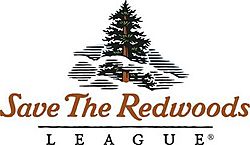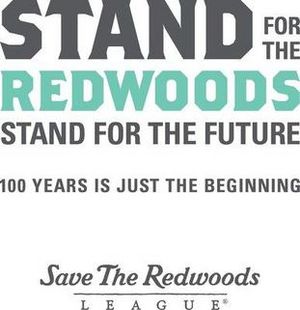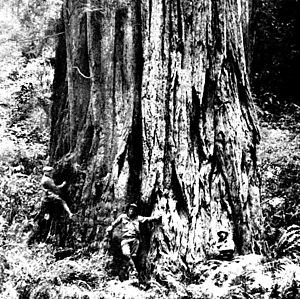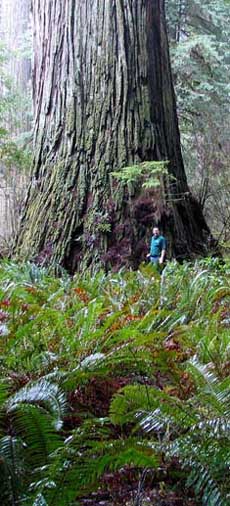Save the Redwoods League facts for kids

Primary logo
|
|

Commemorative centennial logo and tagline
|
|
| Abbreviation | StRL |
|---|---|
| Motto | Stand for the Redwoods, Stand for the Future |
| Formation | 1918 |
| Founders |
|
| Type | Land trust |
| Legal status | Nonprofit organization |
| Purpose | Forest conservation |
| Headquarters | 111 Sutter St., 11th Floor San Francisco, CA 94104 |
|
Region
|
N. California coastal forests |
| Methods | Conservation easements |
| Samuel M. Hodder | |
| Justin Faggioli | |
| Rolando Cohen | |
|
CDO
|
Tim Whalen |
| 13 members | |
|
Revenue (2018)
|
US$21,715,569 |
| Expenses (2018) | US$14,956,727 |
| Endowment (2018) | US$100,129,734 |
|
Staff (2018)
|
8 |
Save the Redwoods League is a group that works to protect and restore amazing coast redwood and giant sequoia trees. They do this by buying land where these trees grow, so it can't be built on.
The League gets money from people, companies, and even the government. They use this money to buy, fix up, and open these forests for everyone to visit. So far, the League has helped protect over 200,000 acres (810 km2) of forestland. By 2018, they had helped create 66 redwood parks and reserves. These include famous places like Humboldt Redwoods State Park and Redwood National and State Parks.
Besides buying and protecting land, Save the Redwoods League also helps restore forests. They support scientific research and offer education programs. They even give small grants to other groups working to protect nature. The League also has a website with lots of information, photos, and updates on their work.
Contents
History of Redwoods Protection
In 1917, a park director named Stephen Mather asked some nature lovers to visit northern California. They wanted to see how the old-growth coast redwoods were doing, as many were being cut down for building materials. These men saw how much damage was being done to the forests.
So, in 1918, John C. Merriam, Madison Grant, and Henry Fairfield Osborn decided to act. They started Save the Redwoods League. Their goal was to protect the ancient redwoods by buying groves and creating public parks. The first people to donate money to the League were Stephen Mather, E.C. Bradley, William Kent, Henry Fairfield Osborn, and Madison Grant.
In 1919, Newton B. Drury became the first leader of Save the Redwoods League. He guided the League for 58 years. He also worked as a leader for the National Park Service and California State Parks.
Also in 1919, women in Humboldt County started their own group called the Women’s Save the Redwoods League. This group had been working for over ten years. In 1908, they sent a petition with over 2,000 children's signatures to the U.S. Forest Service. They asked President Theodore Roosevelt to create a national redwood park.
Newton B. Drury and the League played a big part in creating the California State Park system. This happened when two bills became law on May 25, 1927.
Key Land Acquisitions
In the 1930s, the League helped protect many important areas:
- The 9,400-acre Rockefeller Forest was added to Humboldt Redwoods State Park.
- The Calaveras North Grove of giant sequoias was saved for Calaveras Big Trees State Park.
- 8,252 acres were protected for Prairie Creek Redwoods State Park.
In 1944, the League bought 4,280 acres for Jedediah Smith Redwoods State Park. The next year, the League and the Garden Club of America raised money for the 5,000-acre National Tribute Grove in that park. This grove honored World War II service members. In 1948, dawn redwoods, which were thought to be extinct, were found in China. The League helped fund scientist Ralph Chaney's trip to study them.
From 1951 to 1959, Newton Drury, from the League, directed the California State Parks system. In 1954, the League helped add the South Grove of giant sequoias to Calaveras Big Trees State Park.
In 1960, the Avenue of the Giants Parkway was created in Humboldt Redwoods State Park. This happened after 40 years of the League buying land. In 1968, after many years of effort, Redwood National Park was officially created by the U.S. Congress.
In the 1970s and 1980s, the League kept protecting land for redwood parks. They helped save 1,662 acres for Purisima Creek Redwoods Open Space Preserve. They also protected the 3,858-acre Big Creek Reserve for Julia Pfeiffer Burns State Park.
In the 1980s and 1990s, the League bought land for Navarro River Redwoods State Park. They also helped acquire land for Limekiln State Park and Wilder Ranch State Park. In 2001, the League bought the Dillonwood giant sequoia grove and gave it to Sequoia National Park. In 2002, the League made its biggest purchase yet: the 25,000-acre Mill Creek forest. This became part of Del Norte Coast Redwoods State Park. In the 2000s, the League protected 7,334 acres for Mendocino Headlands State Park. In 2009, the League started its Redwood Climate Change Initiative at Humboldt State University.
In the 2010s, the League helped protect many areas. These included Noyo River Redwoods, Four Corners, the Orick Mill Site, Peters Creek, and Boulder Creek old-growth forests. They also saved Big River-Mendocino Old-Growth Redwoods. The League also helped protect land through special agreements called conservation easements. These covered the 15,000-acre Mailliard Ranch, the 8,500-acre San Vicente Redwoods, and 870-acre Stewarts Point.
In 2018, the League celebrated its 100th birthday. They started a campaign called “Stand for the Redwoods, Stand for the Future.” They also shared a plan to "double the size of coast redwood forests in parks and reserves to 800,000 acres." The California State Senate declared 2018 the "Year of the Redwoods." California Governor Jerry Brown also declared October 2018 as “California Redwoods Month.” He called redwoods a "globally significant treasure."
You can find an interactive timeline of redwoods history and the League's work on their website.
Science and Research for Redwoods
The League uses a plan called the Vibrant Forests Plan. This plan helps them make smart choices about protecting redwood and giant sequoia ecosystems. Their decisions about buying land, caring for forests, and restoring them are all guided by this science-based plan.
In 2018, the League released its first State of the Redwoods Conservation Report. This report uses scientific research to look at the dangers facing redwoods. It checks how much progress has been made to reduce these dangers. Some key dangers include how much forest is still unprotected, the number of old-growth trees, human impact, and how ready forests are for fires.
The League also has a strong scientific research program. They want to learn more about redwood forests and the plants and animals that live there. Their Research Grants Program gives money to scientists studying redwood ecosystems. They also study endangered species and how climate change affects the forests. Some big research projects led by the League include the Redwoods and Climate Change Initiative (RCCI) and the Redwood Genome Project. They also have Citizen Science Programs where people can help with research.
LiDAR is a special technology the League uses. It helps researchers measure tree height, how much wood is in a tree, and how many leaves it has. This information is useful for planting new trees and finding the tallest redwood trees. The League first used LiDAR thanks to a grant from Kenneth Fisher.
Protecting Forests and Parks
Since it started, the League has protected over 200,000 acres of ancient redwoods. The land they buy is usually given to California State Parks or the National Park Service. This helps make sure the redwoods are protected forever. It also allows the public to enjoy and learn about them.
The League also helps create and expand local parks and preserves. Many of these places are open for everyone to visit. For example, the League helped create the Purisima Creek Redwoods Open Space Preserve. This preserve is part of the Midpeninsula Regional Open Space District in the San Francisco Bay Area.
Restoring Redwood Forests
Today, less than five percent of the original ancient redwood forest remains. The League is working hard to bring back the features of old forests to younger redwood stands. They have a partnership with the National Park Service and California State Parks called Redwoods Rising. Together, they are restoring thousands of acres in Redwood National and State Parks. This includes 25,000 acres (100 km2) in the Mill Creek watershed, which was heavily logged.
About one-third of giant sequoia groves were partly or heavily logged. Restoring these forests is very important for their protection. It helps them grow back to have more of their original old-growth features.
Learning About Redwoods
The League offers many educational programs and materials for students from kindergarten to high school. These programs help students learn about redwood forests in the classroom and on field trips. Kids get to learn STEM subjects (Science, Technology, Engineering, Math) from real-world examples. These programs also inspire students to protect the forests. They can even discover career paths in science, park work, and forest management. The League gives many resources directly to teachers. They also work with other groups to reach more students, for example, by giving educational grants.
Memorial Groves

In 1921, Dr. John C. Phillips donated money to buy land for the Raynal Bolling Memorial Grove. This grove is in the Humboldt Redwoods State Park. In the same year, the Stephen T. Mather – William Kent Grove was also created in that park.
Since 1921, the League has created over 1,000 redwood memorial groves. These groves are in more than thirty of California's redwood parks. One grove is named after Newton B. Drury. He was a leader of the League for many years and also directed the National Park Service. Another grove is named after Drury and his brother Aubrey.
The League still has a program where people can donate money to name a grove or tree. This helps raise funds for their mission. In return for a donation, a grove or tree can be named to remember or honor a person, family, or group.
Founders Grove
In 1931, Major Frederick Russell Burnham asked for a survey near Bull Flat Creek. This was a place where League founder Madison Grant thought the world's tallest tree might be. When a 364-foot redwood tree was found there, the California State Park Commission dedicated it. On September 13, 1931, they called it a "living monument symbolizing eternal life." Burnham gave the main speech, saying, "It is an ancient and racial urge that has brought us together today in the shade of this far Western forest like the druids of old." The Founders Tree quickly became, and still is, the most visited spot in the redwood region. Many ceremonies have been held there. The tree's height has since been measured again as 346.1 feet.


